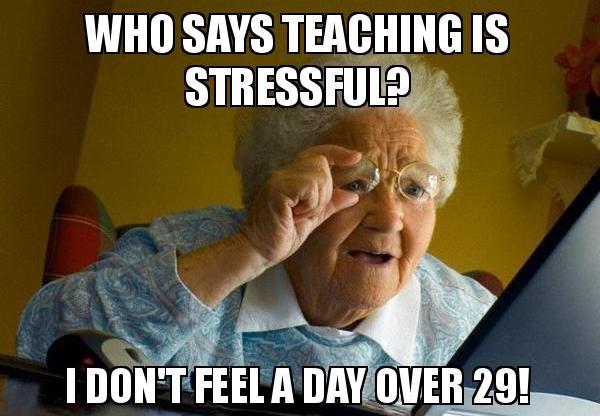
Addressing The Problem with Homework
Many educators are starting to recognize the problem with homework. And while homework is almost universal, there is little evidence that it actually works.

My own experience with teacher stress can be summed up in one sleepless night.
It was 3 am. My grades were due at 8 am. I could probably turn them in by the end of the day without catching too much heat.
But I only had one prep that day. And coaching after school. Even if I went to bed now, it would still be a rough day on 5 hours sleep.
Entering the grades wasn’t really the hard part. The hard part was that I still had 30 papers to grade. I opted for coffee and an all-nighter. (I was in my 20’s, and could still do that sort of thing).
As I thumbed through the stack of papers, I noticed a difference. The ones I had completed earlier in the week showed a great attention to detail. Each had ample proofreading marks and a long narrative at the end, filled with ‘Great Job’s and ‘Well Said’s.
The last few were all business. A few notes sprinkled throughout and bullet points at the end.
It was also the night I came up with my ‘rule of 10.’ Once I found ten typos, I drew a line across the page and stopped reading. The student would have to do another round of proofreading and resubmit.
As a student, I had received both ‘top-of-stack’ feedback and the ‘bottom-of-stack’ feedback. I finally understood what had been going on at the other end of the pen.
This all-nighter was an exceptional experience. But late nights and extreme stress were pretty typical during my first years in the classroom.
 The level of stress teachers face can vary considerably from school to school. I’ve worked in schools where I had almost total creative control. And where students did pretty much anything I asked of them. But I’ve also worked in schools where disengagement and behavior challenges were the norm. In one school, a student punched the principal during recess and was back in my classroom the next week.
The level of stress teachers face can vary considerably from school to school. I’ve worked in schools where I had almost total creative control. And where students did pretty much anything I asked of them. But I’ve also worked in schools where disengagement and behavior challenges were the norm. In one school, a student punched the principal during recess and was back in my classroom the next week.
At the time, I figured it was all part of the job. Teachers do whatever it takes to support our students. Isn’t an all-nighter a great way to show we care? Besides, we have summers off. Working crazy hours during the school year just balances the scales.
But there’s something unique about the challenges of teaching. Most jobs are demanding in one or two ways. Some are physically challenging. Others are mentally demanding or emotionally draining.
But teachers face all of the above. We’re asked to forge meaningful relationships with dozens of students a year. Not to mention their parents. We spent most of the day on our feet (or at least we did). Today, it’s hour after hour of Zoom Conferences or Google Meets.
And once everyone else leaves, the work of planning and grading begins.
A study by the Gates Foundation showed that teachers work an average of 53 hours per week. Most of us work summer jobs.
So no matter how well we manage our time, or how much experience we have, teacher stress is inevitable. Which is why it’s crucial that teachers do all we can to protect ourselves from burnout.
Overwhelmed teachers can’t be fully present for our students. In order to be inspiring, supportive, and engaging, we need to practice self-care. And I’m not just talking about meditation and healthy eating. The best way teachers can care for ourselves is to keep our workload reasonable.
When we eliminate unnecessary sources of stress, we have more to give our students emotionally. We have more time to plan engaging lessons. Simply put, we become better teachers.
Over the years, I found five bad habits that were making my job more stressful than it needed to be. Once I eliminated these habits, teaching felt less like a triathlon and more like an invigorating hike. I never got to the point where teaching was a walk in the park. But I did find a healthy balance.
As a result, I became a better teacher. I was able to give more to my students. When they acted out or failed to meet expectations, I could stay calm and focus on their needs, instead of reacting.
If you’re feeling frustrated and overwhelmed, you probably have one (or more) of the five stress-causing habits below. Breaking just one of these habits can seriously reduce your overall stress level.
I used to have a habit of assigning too much work.
I didn’t realize it was a problem until a few of my students wanted to re-do everything. Homework, classwork, even extra credit.
If I graded it, they wanted to re-do it. If I refused, I got an e-mail from their parents.
It seemed crazy to me. I understood retaking a test, but homework? When they made one mistake? I kept thinking, “What’s the big deal? These assignments aren’t even that important.”
That thought led to another — “If it’s not important, why assign it?”
At the time, I felt that the more grades in my book, the more evidence I had for report cards. Besides, wasn’t assigning work just what teachers do?
But these reasons weren’t good enough. Before assigning anything, we need to be sure it helps students develop necessary skills. And if we assign it, we end up having to grade it – at least once. Because if our feedback is meaningful, they should want to revise.
I eventually cut back on the amount of work I assigned. Instead of piling on worksheets and exercises, I focused on a few meaningful assignments per quarter. Revision and collaboration were built into the process. I also incorporated personalized learning, so students could get extra practice without creating more to grade.
Soon, I stopped feeling like I was constantly digging out from under a pile of paperwork. And my students got ample, meaningful, feedback. Managing my grading also allowed me to be there for students in other, more meaningful ways.
Another stress-inducing habit I had as a new teacher was trying to control my students. And nothing causes teacher stress like an out-of-control classroom.
But the idea that we should control our students is a bit misguided. We can urge them in the right direction. And we should make clear the consequences of their decisions.
But at the end of the day, students control their own actions. I can remember many times when I tried, unsuccessfully, to ‘keep a student in line.’ Once it was literally about getting in line. It was my first year, and I was bringing my class in from recess. One student refused to line up.
I spoke sternly. I threatened.
He continued to strut around the playground singing, “I do what I want, I do what I want.”
I felt trapped. I couldn’t physically drag him into the school…could I?
The whole class was watching the showdown. “What will the principal think if I can’t control one 12 -year-old? What would the other students think?
Were this to happen today, I would simply let the student know that he can make his own decisions, and inform him of the consequences. If he refused to comply, I would just take the other students to class and notify the office.
But I’ve seen how telling students they are in control can immediately defuse tense situations. “It’s up to you. Are you sure you want to do this?”
Instead of trying to control the class, opt for a partnership. When students are looking for a conflict with authority, simply decline to play the part. Be the guide that helps them make good decisions. You’ll save yourself loads of emotional energy.
When people hear I’m a teacher, a lot of them say things like, “I don’t know how you do it. Kids are so tough!”
I’ve always enjoyed working with kids. And I’ve found relating to them to be relatively easy. The tough part for me was the parents.
Parents would ask me to change grades, even ones they knew were were fair and accurate. Some liked to tell me how their taxes or tuition payments paid my salary. Others would chuckle and ask if I’d ever heard the saying, “Those who can’t do, teach.” Hilarious.
But looking back, I wasted too much time and energy trying to manage parents.
If a child didn’t do their homework, I emailed home. To me, this was a mandatory notification. But to them, it was a command: “Make Billy do his homework.”
I recently saw a picture posted by a teacher in a Facebook group. It showed a backpack with a note stapled to the outside. “Make sure you sign the permission slip this time. It’s in the bag.”
“Maybe I’ll get the permission slip back for once,” she wrote. The parent, furious over the ‘ruined backpack,’ contacted the principal.
What a waste of time and energy! If the child doesn’t bring a signed permission slip, let them miss the trip. But too often, we stress ourselves out trying to manage parents.
What happens in the home is important. But it’s not our job. And that includes homework.
We need to save our energy for managing what happens in the classroom. Focus on what’s within our control, and let the rest go.
Students deserve feedback on their work. And providing timely feedback is possibly the most important — and most time-consuming — aspect of our work.
But we’ve all seen what can happen when we return a major assignment. We go through the work carefully. Find every error. We don’t just correct it, we explain exactly how to fix it.

And as soon as we hand the work back to students, they flip to the back to see the grade. Too few take time to think about what they did wrong or how to improve. They just want to know “what they got.”
I once attended a powerful workshop on writing instruction. The presenter hammered the mantra “Don’t fix the writing. Teach the writer.”
This mantra applies to any subject. Our goal is to educate, not to correct. And written feedback does a poor job of teaching.
Giving written feedback on how to factor a polynomial or fix a dangling modifier is a massive waste of time. Even if the student reads this, they probably won’t process it. They’ve heard it and seen it before. And they still made the mistake.
Limit feedback to a few bullet points per assignment. And instead of fixing their mistakes, show students where the mistakes are. Then, have them reflect on their mistakes and make corrections as a class activity.
You’ll cut your grading time in half. And your students will learn a lot more from the process.
Some people think that teachers are resistant to change. In my work as a consultant, I haven’t found that to be the case.
Instead, I find that most educators are hungry for new ideas. We understand the challenges facing our schools and our students. We’re more-than-willing to try anything that will help them. The problem, as I see it, isn’t that we’re less willing to part with the old ways.
In my workshops on personalized learning and inquiry-based learning, teachers tell me they would love to try these models of instruction. They plan to use them to “supplement” their current approach. But they have a hard time telling me what they will take out to make room for the new strategies.
Educators who are the most eager to innovate are often the most likely to suffer from teacher stress.
This relates to teaching methods, resources, websites, you-name-it. The reality is that school schedules already have 10 pounds of learning stuffed in a 5 pound sack. Every minute of instructional time and planning time are usually spoken for.
So before you commit to putting anything new on your plate, first decide what you will take off.
You’ll never get rid of teacher stress entirely. Even if you remove these five sources of stress, your stress levels are still likely to be higher than in many other professions.
Your school’s rules may prevent you from following some of these tips. And in these cases, you’ll need to be creative about fulfilling mandates while also doing what is best for you and your students.
But no matter where you teach, you’ll never be your best self if you are overwhelmed. Find one item off the list to improve upon, and take it from there.
A great place to start is by downloading The Reflective Teaching Guide. It includes practical tips, a self-reflection, and goal-setting sheets. Teachers who complete The Guide take control of their personal growth, and learn to do more by doing less.
If you’d prefer one-on-one support from a veteran educator, sign up for a free consultation with one of our instructional coaches. Your coach can help you with planning, content, or classroom management. Or they can help you lower your stress, just by giving you the space to talk through your challenges.
GET YOUR FREE GUIDE TO REFLECTIVE TEACHING
 Jeff Lisciandrello is the founder of Room to Discover and an education consultant specializing in student-centered learning. His 3-Bridges Design for Learning helps schools explore innovative practices within traditional settings. He enjoys helping educators embrace inquiry-based and personalized approaches to instruction. You can connect with him via Twitter @EdTechJeff
Jeff Lisciandrello is the founder of Room to Discover and an education consultant specializing in student-centered learning. His 3-Bridges Design for Learning helps schools explore innovative practices within traditional settings. He enjoys helping educators embrace inquiry-based and personalized approaches to instruction. You can connect with him via Twitter @EdTechJeff

Many educators are starting to recognize the problem with homework. And while homework is almost universal, there is little evidence that it actually works.

Does the Danielson Rubric improve teaching? Maybe it’s an unfair question. After all, it’s a rubric, not a training program. But…

Looking for a simple way to identify effective teaching? Consider how you (or your team) are performing in each of these three critical domains.